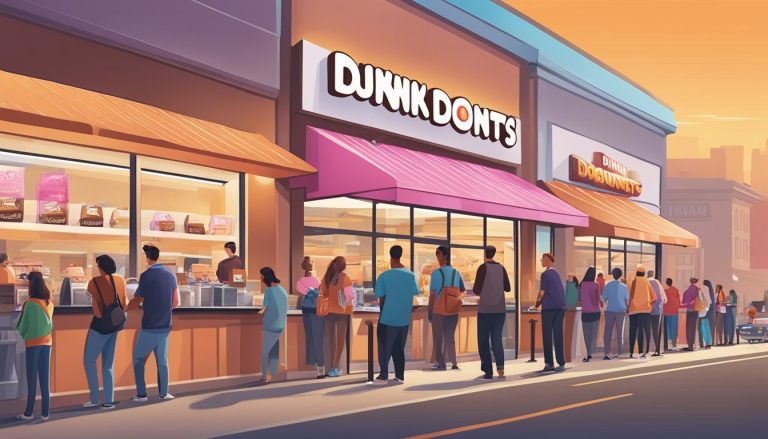Dunkin’ has embraced technology to revolutionize the breakfast experience for its customers. The coffee giant’s mobile app allows patrons to order ahead, earn rewards, and personalize their drinks, creating a seamless journey that meets modern consumers’ demands. This digital approach has become a cornerstone of Dunkin’s strategy, enhancing customer engagement and driving brand loyalty.
The company’s commitment to innovation extends beyond its app. Dunkin’ has implemented digital platforms to streamline operations and improve service efficiency. These technological advancements have enabled the brand to adapt to changing consumer preferences, particularly as breakfast habits evolve in response to shifting work patterns and lifestyles.
By leveraging technology, Dunkin’ has positioned itself at the forefront of the competitive breakfast market. The brand’s digital initiatives not only cater to convenience-seeking customers but also provide valuable data insights. This information allows Dunkin’ to refine its offerings and marketing strategies, ensuring it remains relevant in an ever-changing landscape.
Brand Evolution of Dunkin’
Dunkin’ has undergone significant brand evolution to stay relevant in the competitive breakfast and coffee market. The company has modernized its identity, rebranded to appeal to changing consumer preferences, and expanded globally.
Building a Modern Brand Identity
Dunkin’ has transformed its image from a traditional donut shop to a modern, versatile quick-service restaurant. The company expanded its menu beyond donuts and coffee to include a wider range of breakfast items, sandwiches, and beverages. This diversification helped attract health-conscious consumers and those seeking variety.
Dunkin’ embraced technology to enhance customer experience. The introduction of mobile ordering and a rewards program streamlined the purchasing process and fostered customer loyalty. These digital initiatives positioned Dunkin’ as an innovative brand in the fast-food sector.
Rebranding and Its Impact on Consumer Perception
In 2019, Dunkin’ Donuts officially rebranded to simply “Dunkin'”. This bold move aimed to emphasize the brand’s broader offerings beyond donuts. The shorter name resonated with the on-the-go lifestyle of its target audience.
The rebranding included a new logo, color scheme, and store designs. These changes created a more modern and inviting atmosphere in Dunkin’ locations. The updated branding helped shift consumer perception from a donut-centric shop to a beverage-led, all-day stop for food and drinks.
Expansion and Scaling the Dunkin’ Experience Globally
Dunkin’ has successfully expanded its presence beyond its New England roots to become a global brand. The company adapted its menu and store formats to suit local tastes in different countries. This flexibility allowed Dunkin’ to thrive in diverse markets.
In India, for example, Dunkin’ tailored its offerings to include local flavors and vegetarian options. This strategy helped the brand gain traction in a market with unique dietary preferences. Dunkin’ also leveraged partnerships with local businesses and sports teams to increase brand visibility and appeal in new markets.
Optimizing Customer Experience
Dunkin’ leverages technology to enhance customer satisfaction and streamline operations. The company focuses on efficient service, rewarding loyalty, and convenient ordering options to meet evolving consumer needs.
Efficient Service Delivery Models
Dunkin’ implements innovative service models to reduce wait times and improve order accuracy. Drive-thru lanes feature digital menu boards and advanced ordering systems, allowing for faster transactions.
Inside stores, self-service kiosks enable customers to place orders quickly without waiting in line. These kiosks integrate with Dunkin’s inventory management system to ensure item availability.
Cashless payment options, including contactless cards and mobile wallets, further speed up the checkout process. This multi-pronged approach to service efficiency helps Dunkin’ handle high customer volumes during peak breakfast hours.
Loyalty Programs and Customer Retention
DD Perks, Dunkin’s digital loyalty program, rewards frequent customers and drives repeat business. Members earn points on purchases, redeemable for free beverages and food items.
The program offers personalized promotions based on individual purchase history and preferences. This data-driven approach increases customer engagement and spending.
DD Perks integrates seamlessly with Dunkin’s mobile app, allowing easy point tracking and reward redemption. Special offers and exclusive menu items for members create additional incentives for program participation.
Innovations in On-The-Go Ordering
Dunkin’s mobile app enables customers to order and pay ahead, bypassing in-store lines. Users can customize drinks, save favorite orders, and schedule pickup times for added convenience.
The app’s geolocation features allow stores to prepare orders as customers approach, ensuring freshness. Dedicated pickup areas for mobile orders streamline the retrieval process.
Dunkin’ continually refines its on-the-go ordering system based on user feedback and usage data. Recent updates include voice ordering capabilities and integration with car infotainment systems for hands-free ordering while driving.
Culinary Innovation and Menu Offerings
Dunkin’ continuously evolves its menu to satisfy customer cravings and stay ahead of food trends. The company’s commitment to innovation spans its iconic coffee, classic donuts, and expanding savory options.
Coffee Choices and Customer Preferences
Dunkin’ offers a wide array of coffee options to cater to diverse tastes. From classic hot and iced coffees to espresso-based drinks, the menu features both traditional and trendy beverages. Cold brew has gained popularity, with Dunkin’ introducing flavored variants like vanilla sweet cream.
The company regularly introduces seasonal flavors, such as pumpkin spice in fall and peppermint mocha during winter holidays. These limited-time offerings create excitement and drive customer visits.
Dunkin’ also focuses on customization, allowing customers to personalize their drinks with various milk options, flavor shots, and sweeteners.
Donut Varieties and Seasonal Specialties
Donuts remain a core part of Dunkin’s identity. The chain offers classic flavors like glazed and chocolate frosted alongside more adventurous options. Filled donuts, such as Boston Kreme and jelly-filled, provide variety for customers.
Seasonal and limited-time donuts keep the menu fresh:
- Valentine’s Day heart-shaped donuts
- Shamrock-themed treats for St. Patrick’s Day
- Halloween-inspired designs in October
Dunkin’ frequently collaborates with popular brands to create unique donut flavors, generating buzz and attracting new customers.
Expanding the Savory Selections
Recognizing changing consumer preferences, Dunkin’ has broadened its savory menu offerings. Breakfast sandwiches now include options like:
- Bacon, egg, and cheese on croissants or bagels
- Turkey sausage, egg, and cheese on English muffins
- Plant-based Beyond Sausage Breakfast Sandwich
The introduction of Snackin’ Bacon in 2020 showcased Dunkin’s ability to innovate beyond traditional breakfast items. This on-the-go snack features high-quality bacon seasoned with black pepper and sweet brown sugar.
Dunkin’ continues to experiment with savory options, including wraps and bowls, to cater to health-conscious customers and those seeking more substantial meal options throughout the day.
Digital Transformation and Marketing
Dunkin’ has embraced technology to revolutionize its breakfast experience. The company leverages digital platforms, social media, and innovative promotional strategies to engage customers and drive sales in an increasingly competitive market.
Adopting Digital Platforms for Sales and Marketing
Dunkin’ has invested heavily in digital platforms to streamline sales and marketing efforts. The Dunkin’ mobile app plays a central role, offering customers a convenient way to order and pay. The app features a loyalty program, rewarding frequent customers with points and personalized offers.
Dunkin’ has also integrated with third-party delivery services to expand its reach. This move caters to the growing demand for convenience and off-premises dining. The company’s digital ordering system allows for customization and easy pick-up, reducing wait times and enhancing customer satisfaction.
Engaging Customers through Social Media
Social media platforms are crucial to Dunkin’s marketing strategy. The brand maintains active profiles on popular networks like Facebook, Instagram, and Twitter. These channels serve multiple purposes:
- Showcasing new products and limited-time offers
- Responding to customer inquiries and feedback
- Sharing user-generated content to build community
- Running contests and giveaways to boost engagement
Dunkin’ often creates buzz-worthy content, like its annual National Donut Day campaigns, to drive social media conversations and increase brand visibility.
Promotional Strategies to Drive Sales
Dunkin’ employs a mix of traditional and digital promotional tactics to boost sales. Some key strategies include:
- Limited-time offers on seasonal menu items
- Partnerships with popular brands for co-branded products
- Mobile app exclusive deals and discounts
- Loyalty program perks, such as free beverages on birthdays
- Targeted email marketing campaigns based on customer preferences
The company also adapts its promotions to current trends and events. For example, during the COVID-19 pandemic, Dunkin’ introduced contactless pickup options and promoted its delivery services to address safety concerns.
Enhancing Accessibility and Convenience

Dunkin’ has leveraged technology to transform the breakfast experience, making it faster and more convenient for customers. The company has focused on streamlining ordering processes and expanding service options to meet evolving consumer needs.
Improving Drive-Thru Efficiency
Dunkin’ has invested in upgrading its drive-thru technology to reduce wait times and enhance order accuracy. Advanced digital menu boards now display personalized recommendations based on time of day, weather, and past customer preferences.
Voice recognition software enables more precise order taking, minimizing errors and speeding up service. Dual drive-thru lanes at select locations further reduce congestion during peak hours.
Automated beverage systems and optimized kitchen layouts have also contributed to faster preparation times, allowing Dunkin’ to serve more customers efficiently through the drive-thru.
Expanding Mobile Order and Payment Options
The Dunkin’ mobile app has become a cornerstone of the brand’s accessibility strategy. Customers can now order and pay ahead, skipping lines and reducing in-store wait times.
The app offers customization options for drinks and food items, saving preferences for quick reordering. Integrated loyalty programs provide rewards and personalized offers, incentivizing repeat visits.
Geofencing technology alerts staff when mobile order customers are approaching, ensuring orders are freshly prepared upon arrival. Dedicated pickup areas for mobile orders further streamline the process.
Integration with Food Delivery Services
Recognizing the growing demand for breakfast delivery, Dunkin’ has partnered with major platforms like Uber Eats and Grubhub. This expansion allows customers to enjoy Dunkin’ products without leaving their homes or offices.
The company has optimized its menu for delivery, focusing on items that travel well. Special packaging maintains food quality and temperature during transit.
Dunkin’ has also implemented integrated systems to seamlessly process delivery orders alongside in-store and drive-thru requests, ensuring efficient fulfillment across all channels.
Fostering Community and Brand Loyalty

Dunkin’ has implemented strategic initiatives to build a loyal customer base and strengthen community ties. These efforts combine technology-driven loyalty programs with local engagement activities to create a sense of belonging among customers.
Loyalty Programs as a Pillar of Brand Loyalty
The DD Perks Rewards Program stands as a cornerstone of Dunkin’s customer retention strategy. This digital loyalty program allows customers to earn points on purchases, redeemable for free beverages. Members receive personalized offers and exclusive perks through the Dunkin’ mobile app.
In 2021, Brand Keys recognized Dunkin’ as the top brand in customer loyalty within its industry. This achievement highlights the effectiveness of the company’s digital-first approach to fostering brand loyalty.
The program’s success is evident in its growing membership. Dunkin’ reported a significant increase in Perks members, with millions of active users engaging regularly with the brand through the app.
Community Initiatives and Local Engagement
Dunkin’ extends its brand presence beyond transactions through community-focused initiatives. The Dunkin’ Joy in Childhood Foundation exemplifies the company’s commitment to local engagement.
This philanthropic arm supports children’s health and hunger relief organizations. By involving customers in these efforts, Dunkin’ creates emotional connections that transcend the typical consumer-brand relationship.
Local promotions and partnerships with schools, sports teams, and community events further embed Dunkin’ into the fabric of neighborhoods. These activities foster a sense of community ownership and pride associated with the brand.
Social media campaigns encourage customers to share their Dunkin’ experiences using branded hashtags. This user-generated content creates a virtual community of brand advocates, amplifying Dunkin’s reach and reinforcing customer loyalty.
Financial and Operational Strategy

Dunkin’ has implemented strategic initiatives to drive growth and profitability while adapting to changing market conditions. The company focuses on pricing optimization, franchise expansion, and sustainability efforts to maintain its competitive edge.
Pricing and Profitability in Competitive Markets
Dunkin’ employs a dynamic pricing strategy to balance profitability with market competitiveness. The company adjusts prices based on local market conditions, customer demographics, and product demand. This approach allows Dunkin’ to maximize revenue while remaining affordable for its target audience.
To enhance profitability, Dunkin’ has shifted its focus from a donut-first to a coffee-first model. This transition has improved profit margins, as coffee sales typically yield higher returns than baked goods.
The company also leverages its digital platform to offer targeted promotions and loyalty rewards. This strategy helps drive customer retention and increases average transaction values.
Franchise Operations and Expansion
Dunkin’ operates primarily through a franchise model, which allows for rapid expansion with minimal capital investment. The company provides franchisees with operational support, marketing resources, and technology solutions to ensure consistency across locations.
Franchise agreements typically include revenue-sharing arrangements and operational standards. This model aligns the interests of franchisees with those of the parent company, promoting overall brand growth.
Dunkin’ carefully selects franchise partners and locations to support its expansion strategy. The company targets both domestic and international markets, with a focus on areas with high foot traffic and strong demand for quick-service offerings.
Investing in Sustainability for Long-Term Growth
Dunkin’ has recognized the importance of sustainability in driving long-term growth and customer loyalty. The company has implemented several initiatives to reduce its environmental impact and improve its corporate social responsibility profile.
Key sustainability efforts include:
- Transitioning to recyclable and biodegradable packaging
- Sourcing coffee beans from sustainable farms
- Implementing energy-efficient equipment in stores
- Reducing water consumption in manufacturing processes
These initiatives not only contribute to environmental conservation but also help Dunkin’ appeal to environmentally conscious consumers. By investing in sustainability, the company aims to secure its position in the market and attract a broader customer base.
Challenges and Future Outlook

Dunkin’ faces significant hurdles in the evolving quick-service restaurant landscape. The company must navigate market pressures while embracing technological innovations to stay competitive and meet changing consumer demands.
Navigating Market Challenges
Dunkin’ contends with fierce competition in the saturated quick-service restaurant market. Rising ingredient costs and labor expenses squeeze profit margins. The brand must balance affordability with quality to retain price-sensitive customers. Traditional advertising methods are losing effectiveness, requiring new strategies to reach consumers. Dunkin’ also grapples with shifting consumer preferences towards healthier options and premium coffee experiences.
Innovations Shaping the Future of Quick Service
Digital initiatives drive Dunkin’s future growth strategy. The company invests in mobile ordering, contactless payments, and loyalty programs to enhance customer convenience. AI-powered menu boards and voice-activated drive-thrus streamline operations. Dunkin’ explores multi-tender options to accommodate diverse payment preferences. Data analytics inform personalized marketing and product development. The brand experiments with automated coffee machines and robotic food preparation to boost efficiency and consistency.




